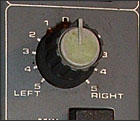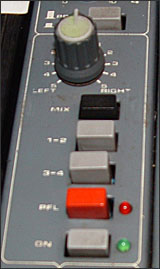Sound Mixers: Channel Assigning & Panning
One of the last sets of controls on each channel, usually just before the fader, is the channel assign and pan.
Pan
Almost all stereo mixers allow you to assign the amount of panning. This is a knob which goes from full left to full right. This is where the channel signal appears on the master mix (or across two subgroups if this is how the channel is assigned). If the knob is turned fully left, the channel audio will only come through the left speaker in the final mix. Turn the knob right to place the channel on the right side of the mix.Assign
This option may be absent on smaller mixers but is quite important on large consoles. The assign buttons determine where the channel signal is sent.In many situations the signal is simply sent to the main master output. In small mixers with no assign controls this happens automatically.
However you may not want a channel to be fed directly into the main mix. The most common alternative is to send the channel to a subgroup first. For example, you could send all the drum microphones to their own dedicated subgroup which is then sent to the main mix. This way, you can adjust the overall level of all the drums by adjusting the subgroup level.
 In the example pictured right, the options are:
In the example pictured right, the options are:- Mix: The channel goes straight to the main stereo mix
- 1-2: The channel goes to subgroup 1 and/or 2. If the pan control is set fully left the channel goes only to subgroup 1, if the pan is set fully right the channel goes only to subgroup 2. If the pan is centered the channel goes to subgroups 1 and 2 equally.
- 3-4: The channel goes to subgroups 3 and/or 4, with the same conditions as above.
You can assign the channel to any combination of the available options.
In some cases you may not want the channel to go to the main mix at all. For example, you may have a channel set up for communicating with the stage via an aux channel. In this case you don't assign the channel anywhere.
Không có nhận xét nào:
Đăng nhận xét